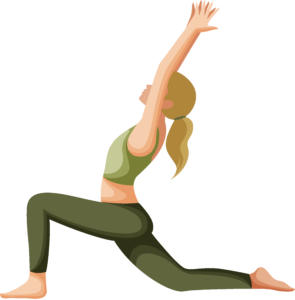Low lunge (Anjaneyasana)
Pose Overview
| Common Name | Low lunge |
| Traditional Sanskrit Name | Anjaneyasana |
| Sanskrit Name Pronunciation | Ahn-juh-nay-ahs-uh-nuh |
| Pose Difficulty | Beginner |
| Drishti
Drishti is the gaze or visual focus point during yoga poses.
Learn more about Drishti |
Upward, towards the sky |
Low Lunge, or Anjaneyasana in Sanskrit, is a yoga pose that is said to be beneficial for stretching out the legs, hips and lower back. The name of the pose comes from the fact that it resembles a lunge, with one foot extended forward and the other foot extended back. The pose is said to be helpful for increasing flexibility and strength in the legs, hips and lower back, and for improving balance and stability. It is also said to be beneficial for relieving tension in the lower back and hips, and for promoting a sense of calm and relaxation.
Benefits of Low lunge
Strengthens the legs, opens the hips, stretches the quadriceps, and improves balance.
How to Enter Low lunge
Start in a lunge position with your right foot forward and your left knee on the ground. Bring your hands to the ground on either side of your right foot. Press through your right foot to lift your chest and engage your core. Reach your arms overhead, pressing your hands together. Hold the pose for a few breaths, then release and repeat on the other side.
How to Exit Low lunge
Release your arms and bring your hands back to the ground. Step your left foot forward and come back to a standing position.
Common Low lunge Modifications & Variations
To make the pose more accessible, you can place your hands on blocks or a chair for support. To deepen the stretch, you can raise your arms overhead and reach towards the back foot. To add more balance, you can raise one arm overhead and reach the other arm towards the front foot.
Common Mistakes with Low lunge
Rounding the lower back instead of engaging the core. Placing too much weight on the front knee, causing strain. Not keeping the back leg straight and engaged.
Safety Guidance
Make sure to keep your front knee aligned with your ankle to avoid knee strain. Keep your core engaged to protect your lower back. Don't push too deep into the stretch if you feel any pain.

